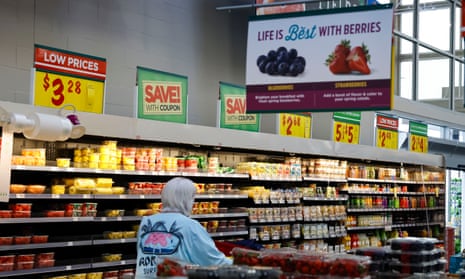America’s leading stock indices came under pressure on Thursday after official data revealed that US economic growth slowed sharply to its weakest rate in almost two years.
But as high interest rates take their toll on the world’s largest economy, inflation continues to loom large.
The Dow Jones industrial average fell by as much as 1.8% in New York before recovering to close down 1%. The S&P 500 also dropped by as much as 1.5%, before finishing down 0.5%. The technology-focused Nasdaq declined 1.9%, before clawing back some of its losses to close down 0.6%.
Gross domestic product increased at an annualized rate of 1.6% in the first quarter, significantly short of the 2.4% rate expected by economists.
But a closely watched measure of inflation also rose faster than anticipated, raising questions about the Federal Reserve’s next steps in its fight to bring down price growth.
The so-called “core” personal consumption expenditures (PCE) price index – which strips out volatile food and energy costs – rose 3.7% in the first three months of the year, according to a report published by the commerce department’s Bureau of Economic Analysis.
The same measure rose by 2% in the last quarter of 2023. While economists had expected an acceleration, the reading was higher than the average 3.4% forecast.
Inflation has been easing in the US, with unemployment remaining low and growth largely resilient, raising hopes that the Fed will guide the world’s largest economy to a so-called “soft landing”, where price growth normalizes and recession is avoided.
But Thursday’s data on the first quarter – with growth fading, and inflation on the rise – will test this confidence.
“Q1’s sluggish increase in GDP likely sets the tone for the rest of 2024,” said Ian Shepherdson, chief economist at Pantheon Macroeconomics, predicting that core PCE inflation “will rise at an annualized rate much closer to 2%” over the next few months.
The first quarter’s core inflation reading could “spook the Fed a little”, said Ryan Sweet, chief US economist at Oxford Economics. “The core PCE deflator rose 3.7% at an annualized rate in Q1, nearly double the clip seen in each of the prior two quarters and stronger than either we or the consensus anticipated.”
after newsletter promotion
While inflation has slowed dramatically since peaking at its highest level in a generation two summers ago, prices still remain far higher than where they stood before the pandemic.
The economy is at the heart of this year’s presidential election campaign, as voters mull whether they felt better off under Joe Biden, or the Trump administration.
“The landing is, and will be, soft,” Biden declared during his State of the Union address last month. “It takes time, but the American people are beginning to feel it. Consumer studies show consumer confidence is soaring.”
But Donald Trump, who is fighting to regain the presidency in November, has claimed inflation is “killing America” under Biden.
On Thursday Janet Yellen, Biden’s treasury secretary, told Reuters that the US economy “continues to perform very, very well”, describing the latest growth as “peculiar, but not concerning”.
The Associated Press contributed reporting
